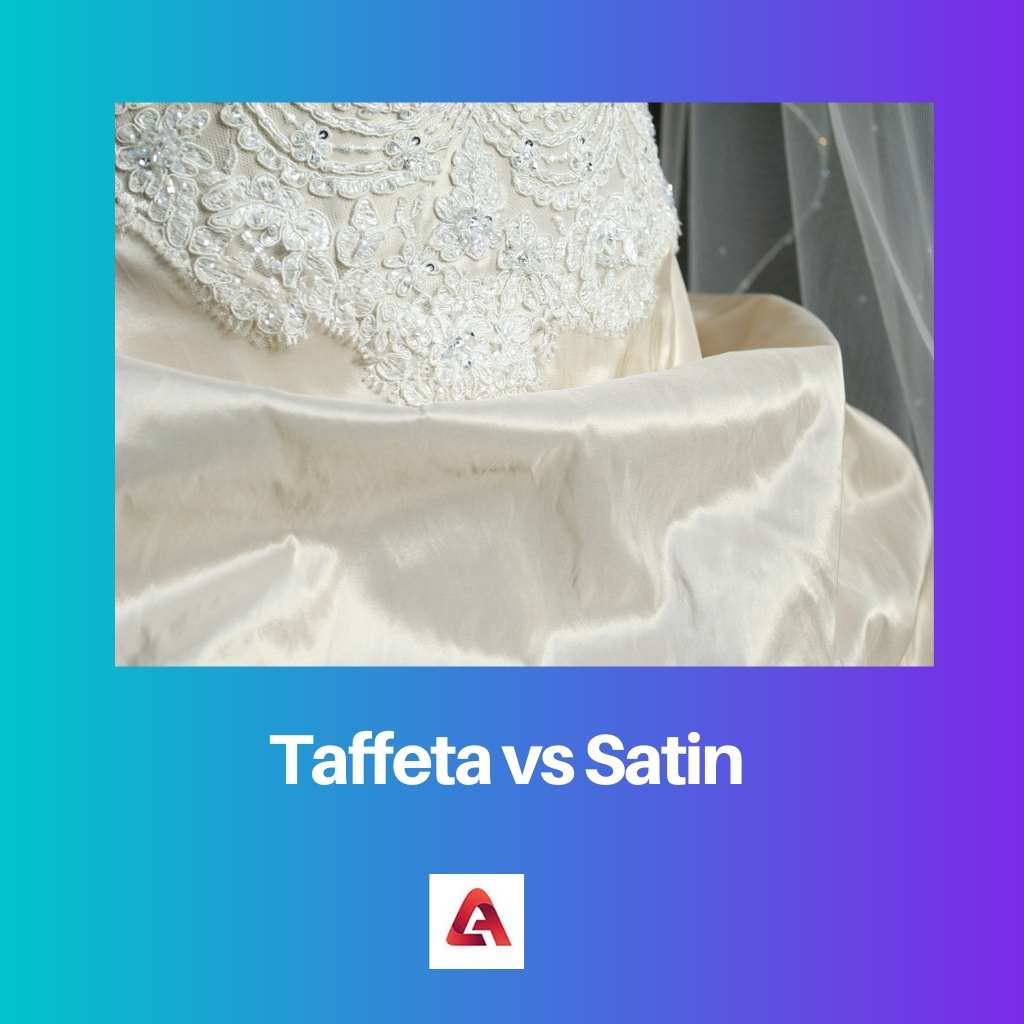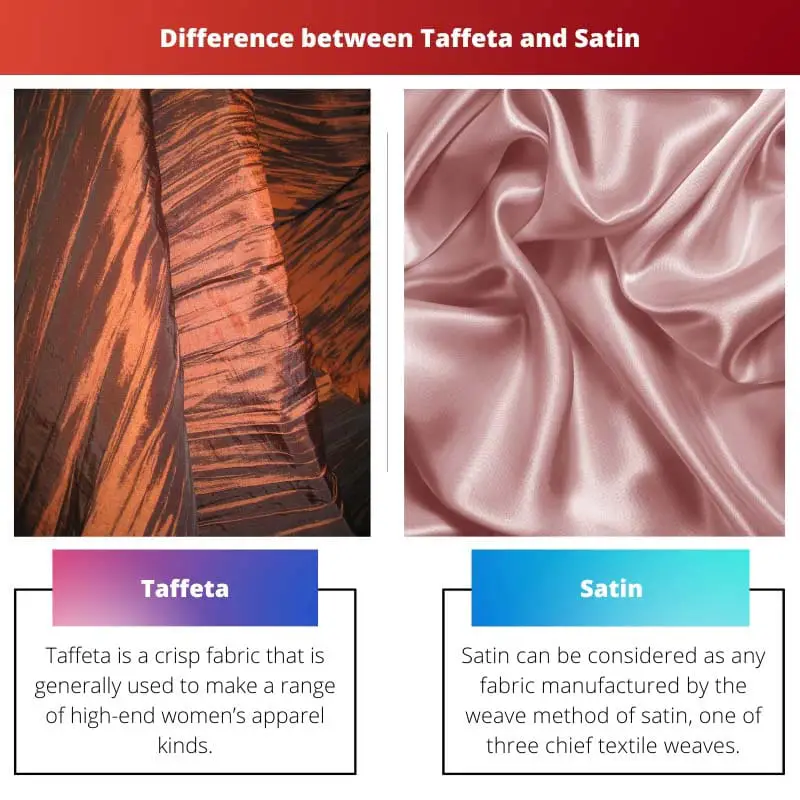In terms of wedding dresses, the brides have a wide range of fabrics to choose from. Lace, velvet, and silk fabric might all be suitable options up to the bride’s preference and season.
Among the more famous bridal fabric options, taffeta and satin are two of them.
Both of them are similar weave’s kind used in making several textile products. Apart from wedding dresses, they are also popular for other formal wear due to their characteristics of shiny fabrics.
In this article, the chief aim is to differentiate taffeta and satin.
Key Takeaways
- Taffeta is a crisp, smooth fabric made from silk or synthetic fibers, characterized by its tightly woven structure and slightly stiff texture.
- Satin is a smooth, lustrous fabric made from silk or synthetic fibers, known for its glossy surface and luxurious feel.
- Both taffeta and satin are popular materials for formal wear, but taffeta is more structured and crisp, while satin is softer and more fluid.
Taffeta vs Satin
Taffeta is a type of cloth made of silk. It is light in weight and can be sewed easily. The texture of the taffeta is crinkled. There are different types of taffeta. Satin is a shiny cloth made of silk and other fabrics. Satin has high durability. There are multiple types of satin. Satin is expensive. It is difficult to wash satin with your hands. It needs to be washed in a machine.

Taffeta is a crisp fabric used to make a range of high-end women’s apparel.
Traditionally, it was manufactured from silk, but with synthetic fibre’s advent, textile manufacturers switched to polyester and rayon to make this fabric.
Satin can be considered as any fabric manufactured by the weave method of satin, one of three chief textile weaves. A smooth surface specifies satin and a dull back and lustrous face.
Satin is made in a wide range of weights for several uses, like upholstery, bedspreads, etc.
Comparison Table
| Parameters of Comparison | Taffeta | Satin |
|---|---|---|
| Origin | Dates back to France mainly in 1782 | Dates back to medieval China’s port city namely, Quanzhou |
| Appearance | Matte appearance | Silky and shiny appearance |
| Feel | Coarser compared to satin | Soft and smooth feel |
| Weight | More lightweight | Comparatively heavier |
| Types | Shot silk, paper, warp printed, faille, stretch, and antique taffeta. | Charmeuse, Messalina, gattar, sultan, slipper, faconne, and many more. |
What is Taffeta?
Taffeta Is a smooth, plain, woven, and crisp fabric manufactured from acetate, polyester, cuprammonium rayons, and silk.
It tends to yield a starched or stiff-like cloth that holds its shape better than many other fabrics and fails to drape or sag.
Taffeta is of two kinds, namely, piece-dyed or yarn-dyed. The yarn-dyed is used in evening dresses due to its stiffness.
Meanwhile, due to the softness of piece-dyed taffeta, it is used in linings. Shot silk Taffeta was a highly sought Byzantine silk’s sought form.
Taffeta fabric is mainly manufactured by twisting yarn, and also many other fabrics are manufactured with this method which means shape-retaining and starched.
Taffeta’s qualities are more representative of its particular attributes than its name. During the 18th century, taffeta was used in certain aviation experiments.
Taffeta is described to be a luxury fabric and is also relatively prone to damage. As a result, it is not in use in clothing on an everyday basis.
On the contrary, seeing satin’s usage in big-ticket apparel such as wedding dresses is frequent.

What is Satin?
A satin weave is a kind of fabric weave that generates a characteristically lustrous or smooth material, particularly with the surface top as glossy.
It is one of three fundamental textile types weaves alongside twill weave and plain weave. More than three wefts characterize it or fill yarns.
These yarn float over a warp yarn, while four warp yarn floats over a single weft yarn. Missed interfacing or described as floats.
These floats explain the high sheen and lustre as unlike in other weaves where light is not scattered when hitting the fibres leading to a stronger reflection.
In case fabric is formed through satin weave with the help of filament and fibres like nylon, polyester, and silk, the corresponding fabric is defined as satin. The fabric forms in mentioned sateen if short-staple yarns are used like cotton.
Fabrics made from satin weaves are more flexible with draping characteristics than plain weaves, allowing them to be formed around compound curves.
The filling yarn in this passes over multiple warp yarns even before interlacing under one yarn’s warp.

Main Differences Between Taffeta and Satin
- When it comes to stiffness, taffeta is stiffer compared to satin and also has a shape retention quality in a good amount. It can hold the volume and shape better in comparison to satin. Meanwhile, satin is perfect for form-fitting dresses.
- The origin of the word, taffeta is in Persian, which means “twisted woven.” On the other hand, satin is a word ultimately the origin of Chinese, which is a derivative of the Chinese place name, Tsinkiang.
- Taffeta is mostly used for making corsets, blouses, evening gowns, coats, curtains, skirts, interior decorations, and many more. On the contrary, satin is used in lingerie, boxer shorts, nightgowns, bed sheets, upholstery, etc.
- The care tips comprised for Taffeta are gentle detergent usage, low heat iron usage, avoiding twisting or wringing, and washing with cold water. On the flip side, using chemical-free detergent or cold water, protection firm direct sunlight, and squeeze avoidance are some of the safety tips for satin.
- Taffeta is produced most from silk, while it can also be woven with nylon, acetate, polyester, or other synthetic fibres. In contrast, satin was produced originally through silk, but modern satin can be made from rayon and polyester.

